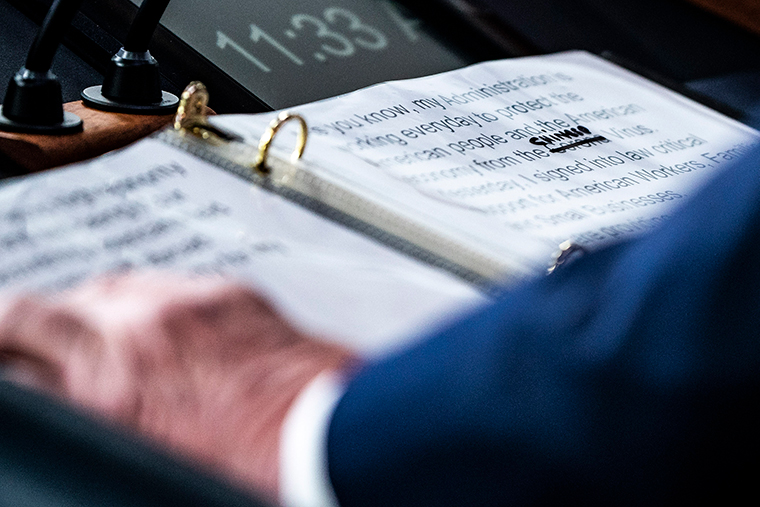Pleas from an Asian-American: we are not a virus
Jabin Botsford/The Washington Post via Getty Images
Trump crossing out “corona” and replacing it with “Chinese” in briefing notes. Courtesy of cnn.com
It’s been everywhere in 2020: plastered across the homepages of our social media, heavily quoted in digital news and boldly printed across the captions of our eight o’clock news for all to see. It’s a virus, permeating the air with deadly poisons of anger, one similar to, and as deadly as, COVID-19. These all-caps-triple-exclamation-point headlines feature the three words that tighten the invisible noose around the necks of Asians all over America: “The Chinese Virus.”
With the increasing prominence of this new, distasteful nomenclature, very few of those unaffected by this term are aware of its cultural impact and the humiliation caused by these three words. In fact, many are blind to their participation in this plague of anger.
When the first COVID-19 patient was clinically admitted in Snohomish County, Washington on Jan. 19, 2020, no American citizen was prepared for the tsunami that would follow.
As ICUs all across the country reached their overflow capacity due to the rapid spread of the virus, grief over the loss of family and friends swallowed the nation. Grocery stores ran out of cleaning supplies, toilet paper and laundry detergent as panicked Americans began stockpiling whatever they could. Businesses began to close down, and owners and employees of gyms, restaurants, theaters and other public gathering places lost their livelihoods.
When America went into lockdown, issuing curfews and regional guidelines to prevent the spread of the virus, millions of Americans experienced the social and psychological effects of limited daily interaction. In short, COVID-19 derailed the lives of most, if not all people in the United States.
The mystery man of Snohomish County, WA had recently returned from Wuhan, China, which is currently known as the place of origin for COVID-19. This fact became the foundation of many theories and accusations directed towards the Chinese government. Many were rightfully angry with China for withholding information that could have prevented thousands of deaths.
However, resentment, bitterness and even racism trickled down to impact the lives of Asians and Asian-Americans, who became victims of mass-projected pain. For months, stories of attempted assault upon Chinese, Korean and Japanese Americans circulated within Asian communities but received little to no press. Referred to by President Donald Trump as the “kung flu” or the “Chinese virus,” COVID-19 lost its original scientific nomenclature and became a racial weapon wielded against Asians.
Press and digital media began to publish articles fully blaming China for the virus’s level of deadliness in America, despite the fact that the first COVID-19 patient was a product of America’s insistence on not issuing a travel ban on flights from Wuhan and other parts of Asia. Though China’s government did play a large part in spreading COVID-19, this culture of hate and blame created by both the media and our president destroyed Asian-American businesses, reputations and livelihoods.
An argument defending the use of the term “Chinese virus” is that it is “epidemiologically correct,” accurately specifying COVID-19’s geographic place of origin. In a White House press conference, President Trump even defended his usage of this terminology.
“It’s not racist at all, no, not at all,” he stated. “It comes from China, that’s why. I want to be accurate.”
However, referring to this disease as one of Chinese origin is not geographically significant. As a country that is 3.7 million square miles in area, this term does little to provide more accurate information about any details regarding COVID-19
In a separate press conference, President Trump was photographed crossing out the word “coronavirus” in his speech notes, replacing it with “Chinese virus.”
Trump’s referral to the pandemic as the “Chinese virus,” despite the existence of a scientifically accurate, CDC and WHO-issued term for COVID-19, proves his hypocrisy and deliberate apathy towards the racial targeting of Asians. For someone who claims to honor “accuracy,” his choice of words puts millions of Asians in America at a high risk of assault, increased discrimination and microaggressions.
As a racial minority in America and a member of a culture that heavily emphasizes not “rocking the boat,” it is nearly impossible to stop this racial targeting. How are we, as individuals within the Asian community, to stop the violence inflicted upon our people when our own president refuses to acknowledge the pain and suffering that this nomenclature causes, continuing to use it in place of a scientifically accurate term?
Well, this is the first step. You’ve nearly finished reading this article, meaning you have the choice to actively exercise your knowledge and avoid your participation in spreading the use of the term “Chinese virus,” or other similar terms. Spreading the word to those you have heard use these terms would greatly benefit the Asian community as well. Only when we are aware of the effect of this nomenclature on our society can we truly say that we have left behind something better for our posterity.











